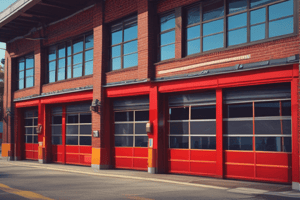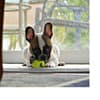Podcast
Questions and Answers
A crime scene sketch is made to portray the information ______ rather than artistically.
A crime scene sketch is made to portray the information ______ rather than artistically.
accurately
Directionality of the overhead view is determined by using a ______.
Directionality of the overhead view is determined by using a ______.
compass
A rough sketch is usually made first on ______ paper in pencil.
A rough sketch is usually made first on ______ paper in pencil.
graph
Measurements of the distances between objects and/or structures are taken using a ______ measure or other measuring devices.
Measurements of the distances between objects and/or structures are taken using a ______ measure or other measuring devices.
Signup and view all the answers
Two measurements taken at right angles to each other or from two ______ points will usually suffice.
Two measurements taken at right angles to each other or from two ______ points will usually suffice.
Signup and view all the answers
A final sketch can be made later using ______, paper and ruler, or a computer.
A final sketch can be made later using ______, paper and ruler, or a computer.
Signup and view all the answers
The original rough sketch should be retained and preserved in case it is needed at a later ______.
The original rough sketch should be retained and preserved in case it is needed at a later ______.
Signup and view all the answers
A crime scene sketch is usually made of the scene as if one is looking straight down (overhead ______) or straight ahead.
A crime scene sketch is usually made of the scene as if one is looking straight down (overhead ______) or straight ahead.
Signup and view all the answers
Use a ______ table for the evidence in your sketch.
Use a ______ table for the evidence in your sketch.
Signup and view all the answers
Once the scene has been thoroughly documented, then the evidence ______ can commence.
Once the scene has been thoroughly documented, then the evidence ______ can commence.
Signup and view all the answers
Study Notes
Smooth Sketch
- A smooth sketch is a finished sketch, often drawn to scale from the information provided in the rough sketch.
- If a sketch is drawn to scale, distances can be eliminated; otherwise, distances need to be shown.
Methods of Sketching
- Coordinate Method: measures the distance of an object from two fixed points, using a baseline and exact dimensions.
- Triangulation Method: useful in outdoor situations, measures distances from two or more reference points.
- Cross-Projection Method: useful for items on or in wall surfaces, measures from a given point on the floor to the wall.
General Rules of Sketching
- Decide what to sketch.
- Consider using a table to help with measurements.
- Eliminate unnecessary measurement lines for clarity.
- Note relationship measurements, which cannot be made on a scale drawing later.
Information to Include in the Sketch
- Crime scene sketcher's full name and assignment.
- Date, time, crime classification, and case number.
- Assistants' full names.
- Address of the crime scene, position, landmark, and compass direction.
- Scale of the drawing, if applicable.
- Major discernible items of physical evidence and critical features of the crime scene.
- Accurate measurements from at least two fixed points or by other methods.
Types of Sketches
- Rough Sketch: drawn free-hand at the crime scene, not to scale, but indicating accurate distances, dimensions, and relative proportions.
- Smooth Sketch: finished, often drawn to scale, and includes accurate measurements.
Importance of Sketches
- Sketches complement photographs and notes.
- Sketches are essential for recording a crime scene, especially when spatial relationships are important.
- Sketches clarify the appearance of the scene and make it easier to comprehend.
- Crime scene sketches can be made using graph paper, pencil, tape measure, and other measuring devices.
Studying That Suits You
Use AI to generate personalized quizzes and flashcards to suit your learning preferences.
Related Documents
Description
Learn about the different methods of sketching in police photography, including smooth sketches and coordinate methods. Understand the importance of scale and distance measurements.





